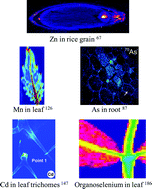Revealing the uptake, transport, localization and speciation of both essential and toxic elements in plants is important for understanding plant homeostasis and metabolism, subsequently, providing information for food and nutrient studies, agriculture activities, as well as environmental research. In the last decade, emerging techniques for elemental imaging and speciation analysis allowed us to obtain increasing knowledge of elemental distribution and availabilities in plants. Chemical imaging techniques include mass spectrometric methods such as secondary ionization mass spectrometry (SIMS), laser ablation inductively coupled plasma mass spectrometry (LA-ICP-MS) and synchrotron-based techniques such as X-ray fluorescence spectroscopy (SRXRF), and so forth. On the other hand, X-ray absorption spectroscopy (XAS) based on synchrotron radiation is capable of in situ investigation of local atomic structure around the central element of interest. This technique can also be operated in tandem with SRXRF to image each element species of interest within plant tissue. In this review, the principles and state-of-the-art of these techniques regarding sample preparation, advantages and limitations, and improvement of sensitivity and spatial resolution are discussed. New results with respect to elemental distribution and speciation in plants revealed by these techniques are presented.

You have access to this article
 Please wait while we load your content...
Something went wrong. Try again?
Please wait while we load your content...
Something went wrong. Try again?


 Please wait while we load your content...
Please wait while we load your content...